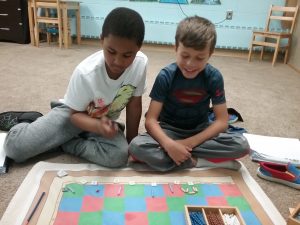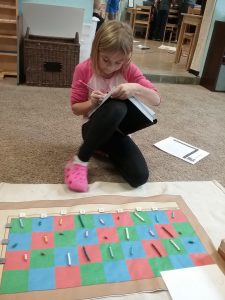Many of you might be seeing “Checkerboard” written on your child’s work plan and wondering to yourselves, “What is a checkerboard and how is it teaching my child math?” This week, I wanted to share with you one of the most popular materials in any Montessori Elementary Classroom – The Multiplication Checkerboard. This material is used in different stages to multiply whole numbers throughout Lower Elementary and then with decimals in Upper Elementary. Montessori Math can be confusing to many of us because it is not taught the way we have experienced learning mathematic and geometric concepts. In most of our schooling, we were taught the quickest and shortest way to come up with the correct answer, often leading us to be confused about where a number came from and feeling like we’d never use that information again. Imagine if we had all been given the time and opportunity to discover formulas and concepts on our own, instead of solely copying down what we were told!
Dr. Montessori wanted her materials to help children develop a “Mathematical Mind.” This meant the goal of math in Montessori schools is not to come up with the correct answer the quickest, but to learn how to think critically and logically. The focus on math in the classroom is on the process of what they are learning, instead of the product. Brain research from “Math Works” by Michael Duffy, shows that Montessori Math materials engage all four lobes of the cerebrum simultaneously, connect the right and left hemispheres of the brain, and actively engage the prefrontal cortex.




The Multiplication Checkerboard is one of the many materials in our classroom that gives your child the opportunity to learn and grow at their own pace, while being challenged. The concrete materials used in Montessori classrooms give students a deeper understanding and a sense of confidence when they come up with their own formulas or solutions to problems.
A Peek into Next Week
Next week Lower Elementary students will talk about factoring, the fundamental needs of early humans, and bisecting angles. Upper Elementary students will look at the characteristics of cells, commas and apostrophes, and the five kingdoms. All students will work on Text-to-World Connections in Reader’s Workshop and will participate in new States of Matter lessons.
REMINDERS: 11/16 OCC Packing. Information was sent home on a flyer and in email!
11/17 Parent-Teacher Conferences – This is a NO SCHOOL day for students. If you haven’t yet, you can sign up here.
11/21 Harvest Party – Parents are invited to come join us for tea and desserts. Come hear what students have learned about the Mayflower. Please arrive at 1:00 pm. More information to follow by email.
